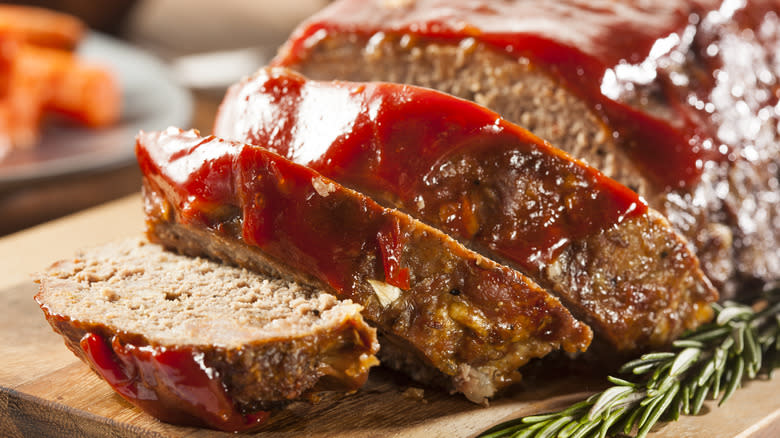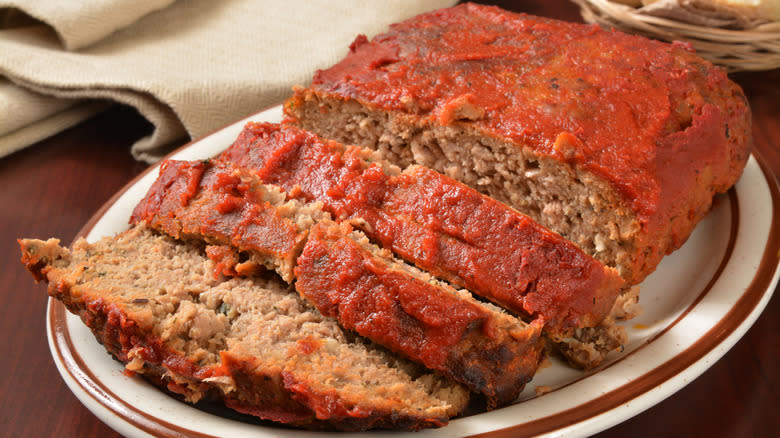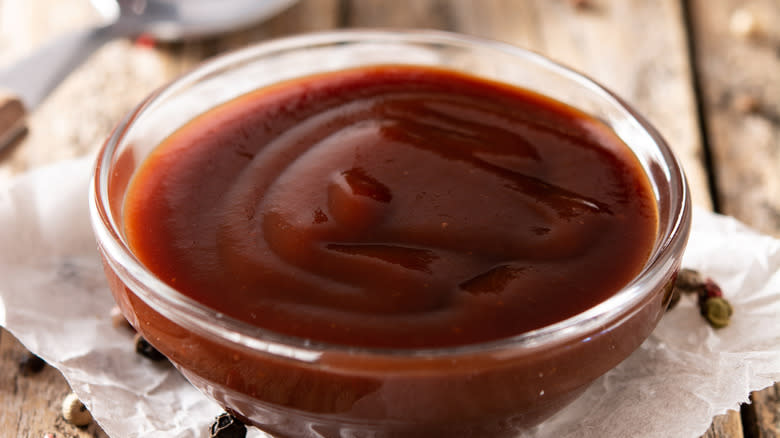Here's Why You Always See Ketchup On Top Of Meatloaf

Meatloaf is one of those dishes that forms a bedrock part of the American cooking legacy, and of course it just wouldn't be a classic beef meatloaf without a glaze of ketchup over the top. Wait, though ... why does meatloaf always come with ketchup? It's such a basic thing that we don't even think to question why we do it or where it came from -- it's just traditional, like tomato soup with grilled cheese. But how did the meatloaf-ketchup combo even get started?
It turns out that while we don't know with absolute certainty, we can hazard some pretty good guesses. Specifically, it seems like ketchup was added to meatloaf as a result of the Great Depression, as a way to add both moisture and flavor to meat at a time when customers were concerned with cost efficiency above all. The flavors present in ketchup naturally balanced what meatloaf was already bringing to the table, making it the logical choice among condiments at the time. Eventually, the trend became so ubiquitous that nobody could imagine meatloaf without ketchup.
Read more: 15 Tips For Making The Best Meatloaf
People Were Looking For A Cheap Way To Flavor And Moisten Dinner

Though meatloaf's origins may go all the way back to ancient Rome, the Romans didn't use tomato ketchup on it for the obvious reason that they didn't have tomato ketchup, as it was invented in 1812 by a guy named James Mease. Indeed, while meatloaf was eaten for centuries in many cultures, as far as anyone can tell, the combination of it and ketchup is a much more recent and uniquely American creation that came about thanks to economic calamity.
The Great Depression heralded meatloaf's rise as a staple of American diets for the simple reason that it's an extremely cost-efficient dish. Binders like eggs and bread crumbs -- along with the fact you can put any ground up meat product in a meatloaf as long as you believe in yourself -- can be used to make it go a lot further than many other proteins. Ketchup, meanwhile, was an extremely cheap condiment, making it a perfect fit as a sauce to add not just flavor, but also moisture to meatloaf recipes. From there, the association became so locked in that by the 1940s and '50s, recipes for meatloaf started appearing on bottles of ketchup themselves. It makes sense, too, as the two qualities ketchup most brings to the table (sweetness from sugar and acid from tomatoes) are ones a meatloaf doesn't possess on its own.
You've Got Other Options For Meatloaf Glaze Aside From Ketchup

Just because ketchup is the standard condiment for meatloaf doesn't mean you shouldn't consider other options; for the best meatloaf topping, you should think beyond ketchup. Barbecue sauce is a choice that's gained tons of traction in recent years -- unsurprising, as it adds a smoky flavor ketchup doesn't bring to the table (of course, it helps that ketchup is the base for a lot of barbecue sauces anyway). Any tomato-based glaze with honey can work great here, too, providing a lot of the same benefit ketchup does but with the dial turned down on its cloying sweetness. And if you want to keep things really simple, you can combine ketchup with another condiment like mustard or mayonnaise (hey, if it works for burgers, why not meatloaf?).
Still, there's nothing wrong with returning to that old ketchup standby. Even if it did come about as a result of the Great Depression, there's a reason ketchup and meatloaf became a classic in the first place.
Read the original article on The Daily Meal.


